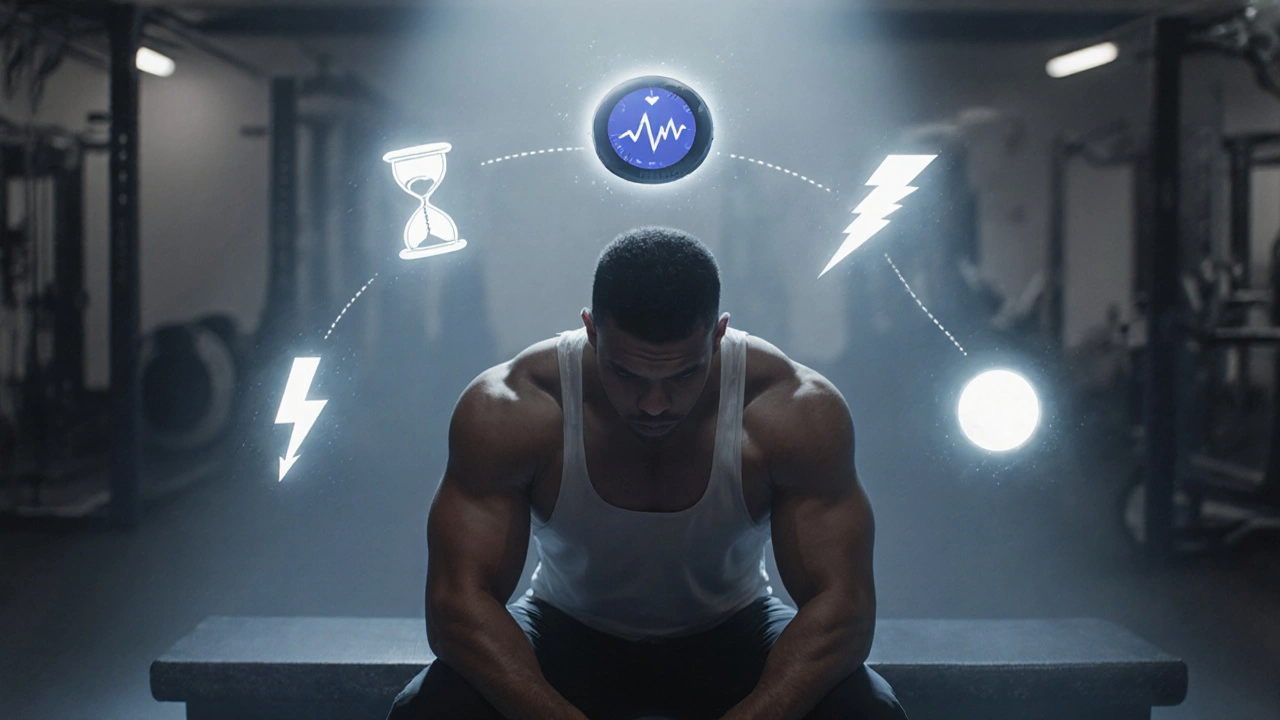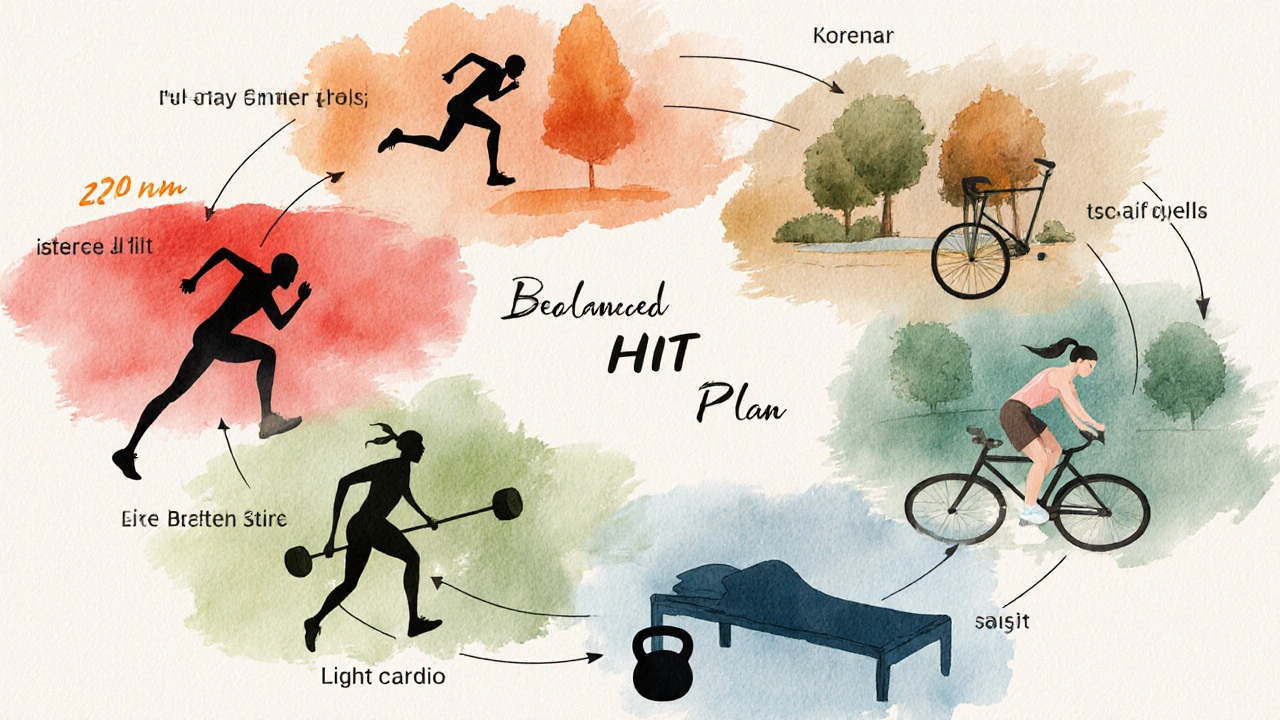
HIIT Safety Calculator
Assess Your HIIT Routine
Your Safety Assessment
People love the buzz around HIIT everyday because a few minutes can feel like a full‑blown cardio session. But is it really okay to crank out high‑intensity interval training (HIIT) every single day? The answer isn’t a simple yes or no - it depends on how you structure the workouts, how your body recovers, and what your fitness goals are.
Key Takeaways
- Most experts recommend 2-4 HIIT sessions per week for optimal results.
- Daily HIIT can work if you keep intensity, volume, and recovery in check.
- Watch for signs of overtraining such as persistent fatigue, soreness, and sleeping problems.
- Incorporate active‑recovery days, lower‑intensity cardio, and proper nutrition to stay safe.
- Adjust the plan based on your age, fitness level, and any medical conditions.
What Is HIIT?
HIIT is a training method that alternates short bursts of maximal effort with brief recovery periods. Typical intervals last 20‑45 seconds, followed by 10‑30 seconds of rest or low‑intensity movement. The whole session can be as short as 10‑20 minutes, yet it taxes both aerobic and anaerobic systems.
How HIIT Impacts Your Body
During a HIIT bout, your cardiovascular system works to deliver oxygen to working muscles at a rate far above resting levels
- This spikes VO2 max the maximum amount of oxygen your body can use during intense exercise, a key predictor of endurance performance.
At the muscular level, the repeated high‑intensity bursts trigger lactate threshold the point where lactate accumulates faster than it can be cleared, nudging your body to become more efficient at clearing metabolic waste.
Because the effort is so demanding, your muscles need time to repair, rebuild glycogen stores, and replenish hormones like cortisol the stress hormone that rises during intense workouts. If recovery is inadequate, cortisol stays elevated, which can impair muscle growth and weaken the immune system.

Risks of Doing HIIT Every Day
Stacking high‑intensity sessions without proper rest can lead to overtraining syndrome a chronic condition marked by performance decline, mood changes, and hormonal imbalance. Common side effects include:
- Persistent muscle soreness that lasts more than 48hours.
- Decreased motivation or “burnout” feelings.
- Elevated resting heart rate, indicating incomplete recovery.
- Sleep disturbances - trouble falling asleep or staying asleep.
- Increased injury risk, especially to joints and tendons.
Moreover, daily spikes in heart rate can stress the heart if you have undisclosed cardiac issues. Always get a medical clearance if you’re over 40, have hypertension, or any chronic condition.
How Often Should You Do HIIT?
The sweet spot for most people is 2-4 sessions per week, spaced out by at least 48hours of lower‑intensity activity. This schedule lets the body reap the metabolic benefits while giving muscles a chance to recover.
| Metric | Every Day | 2‑4×PerWeek (Recommended) |
|---|---|---|
| Average Session Length | 15min (low‑volume) | 20‑30min (full‑effort) |
| Recovery Needs | Active recovery each day (light jog, walk) | Full rest or low‑intensity cardio on off‑days |
| Risk of Overtraining | High | Low‑moderate |
| Performance Gains (VO2 max) | Modest | Significant (5‑10% increase) |
| Injury Rate | ↑ | ↓ |
If you really want to train daily, keep the sessions short (<10‑15min), lower the work‑to‑rest ratio (e.g., 20seconds on / 40seconds off), and rotate muscle groups.
Warning Signs You’re Overdoing It
Listening to your body is the easiest way to avoid trouble. Watch for:
- Unexplained fatigue that lingers throughout the day.
- Joint pain that isn’t relieved by stretching.
- Decline in performance (you can’t hit the same speed or power).
- Reduced appetite or sudden weight loss.
- Elevated resting heart rate (>10bpm above your normal morning rate).
When you notice any of these, step back, add a rest day, and focus on nutrition and sleep.

Making Daily HIIT Safer
Here are proven tweaks to keep daily HIIT from turning into a hazard:
- Vary the intensity. Alternate between “hard” (90‑95% max heart rate) and “moderate” (70‑80%).
- Hard day: 30‑second sprints, 30‑second rest.
- Moderate day: 45‑second bodyweight circuits, 45‑second rest.
- Shorten the volume. Keep daily sessions under 15minutes.
- Example: 6×20‑second intervals + 30‑second rest = 6min total.
- Prioritize active recovery. Use low‑intensity cardio, yoga, or mobility drills on “light” days.
- Walking, easy cycling, or gentle swimming for 20‑30min.
- Fuel your body. Replenish glycogen the stored form of glucose in muscles and liver with carbs post‑workout and include protein for muscle repair.
- Sleep well. Aim for 7‑9hours; quality sleep drives hormone balance and tissue repair.
- Track heart‑rate zones. Use a fitness tracker to stay within your target zone and avoid chronic spikes above 90% of max heart rate.
By embedding these habits, you can enjoy the metabolic boost of daily HIIT while keeping injury risk low.
Sample Weekly Layout (Balanced Approach)
Below is a realistic plan for someone who wants to train most days but still respects recovery:
- Monday - Hard HIIT: 8×20sec sprint, 40sec walk (total 12min).
- Tuesday - Active Recovery: 30min brisk walk + 10min mobility.
- Wednesday - Moderate HIIT: 6×45sec kettlebell circuit, 45sec rest.
- Thursday - Strength Day: Full‑body weightlifting (no HIIT).
- Friday - Hard HIIT: 10×15sec bike sprints, 30sec easy pedal.
- Saturday - Light Cardio: 25min easy jog or swim.
- Sunday - Rest: Complete day off, focus on sleep and nutrition.
This schedule hits HIIT three times, blends other modalities, and leaves two true rest days.
Bottom Line
Doing HIIT every single day isn’t a universal no‑go, but it requires careful programming. Most people see better results when they limit intense sessions to 2‑4 times per week and give the body time to recover. If you love the idea of daily work, scale back the volume, mix intensities, and pay close attention to sleep, nutrition, and any warning signs.
Frequently Asked Questions
Can beginners do HIIT daily?
For most beginners, it’s safer to start with 2‑3 sessions per week. Their bodies need more time to adapt to the high stress on the cardiovascular and muscular systems.
How long should a daily HIIT session be?
Keep it under 15minutes, with each work interval no longer than 30seconds and equal or longer rest periods. Shorter sessions limit cortisol buildup and reduce injury risk.
Is HIIT better than steady‑state cardio for weight loss?
HIIT can burn more calories in a shorter time and elevate post‑exercise metabolism (EPOC). However, consistency matters - if you can’t recover, steady cardio may produce steadier results.
What’s the best way to measure recovery?
Track resting heart rate each morning, monitor perceived soreness, and keep a sleep quality log. A sudden rise in resting heart rate or lingering soreness signals insufficient recovery.
Can I combine HIIT with strength training?
Yes - just separate the sessions by at least 48hours or do a light HIIT day after a heavy lift day. Alternating reduces the cumulative stress on the same muscle groups.
